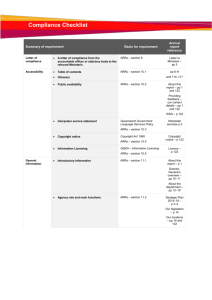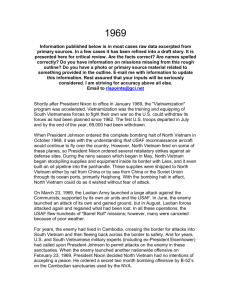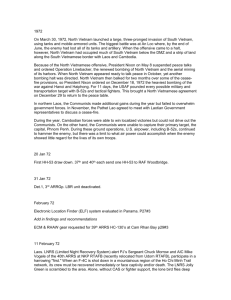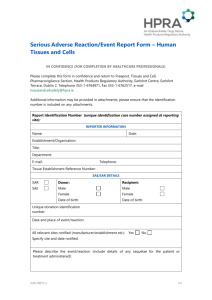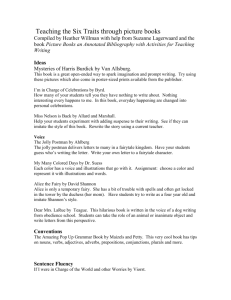1970 - PJs in Vietnam
advertisement
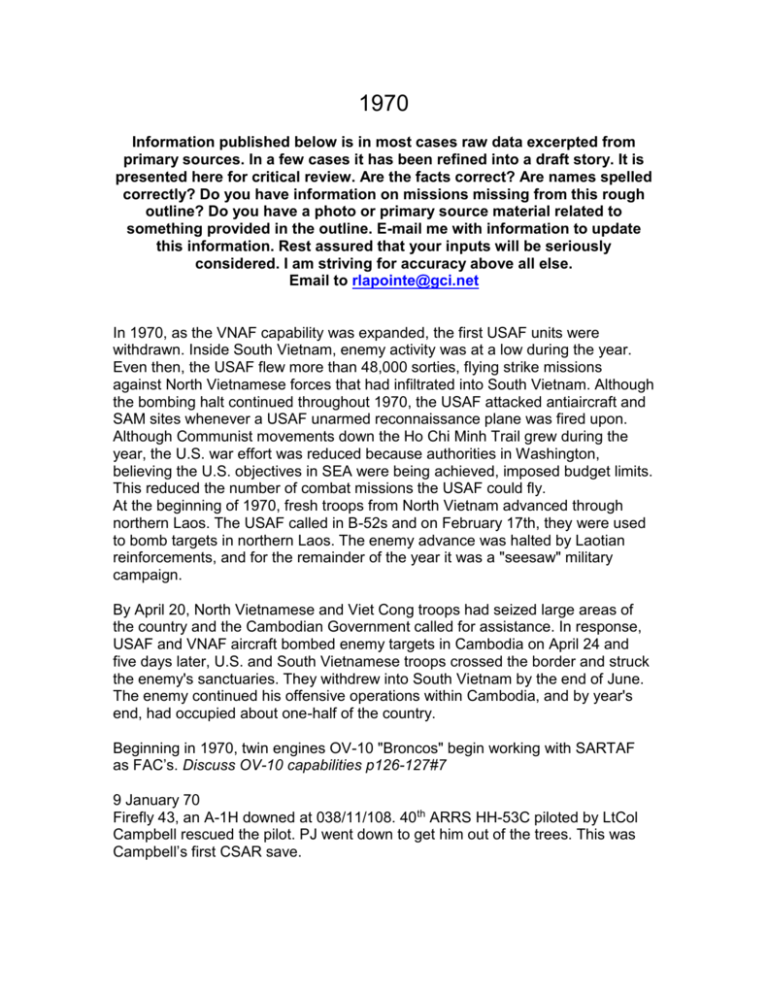
1970 Information published below is in most cases raw data excerpted from primary sources. In a few cases it has been refined into a draft story. It is presented here for critical review. Are the facts correct? Are names spelled correctly? Do you have information on missions missing from this rough outline? Do you have a photo or primary source material related to something provided in the outline. E-mail me with information to update this information. Rest assured that your inputs will be seriously considered. I am striving for accuracy above all else. Email to rlapointe@gci.net In 1970, as the VNAF capability was expanded, the first USAF units were withdrawn. Inside South Vietnam, enemy activity was at a low during the year. Even then, the USAF flew more than 48,000 sorties, flying strike missions against North Vietnamese forces that had infiltrated into South Vietnam. Although the bombing halt continued throughout 1970, the USAF attacked antiaircraft and SAM sites whenever a USAF unarmed reconnaissance plane was fired upon. Although Communist movements down the Ho Chi Minh Trail grew during the year, the U.S. war effort was reduced because authorities in Washington, believing the U.S. objectives in SEA were being achieved, imposed budget limits. This reduced the number of combat missions the USAF could fly. At the beginning of 1970, fresh troops from North Vietnam advanced through northern Laos. The USAF called in B-52s and on February 17th, they were used to bomb targets in northern Laos. The enemy advance was halted by Laotian reinforcements, and for the remainder of the year it was a "seesaw" military campaign. By April 20, North Vietnamese and Viet Cong troops had seized large areas of the country and the Cambodian Government called for assistance. In response, USAF and VNAF aircraft bombed enemy targets in Cambodia on April 24 and five days later, U.S. and South Vietnamese troops crossed the border and struck the enemy's sanctuaries. They withdrew into South Vietnam by the end of June. The enemy continued his offensive operations within Cambodia, and by year's end, had occupied about one-half of the country. Beginning in 1970, twin engines OV-10 "Broncos" begin working with SARTAF as FAC’s. Discuss OV-10 capabilities p126-127#7 9 January 70 Firefly 43, an A-1H downed at 038/11/108. 40th ARRS HH-53C piloted by LtCol Campbell rescued the pilot. PJ went down to get him out of the trees. This was Campbell’s first CSAR save. 27 January 70 OV-10, Nail 35 downed at 040/68/108. HH-53 from 40th ARRS, A/C Captain Reader made pickup. Cookie 02, F-105 downed at 040/68/108. Picked up by HH-53 from 40th ARRS, A/C Captain Brown. 28 January 70 SENIOR MASTER SERGEANT WILLIAM D. PRUETT and MASTER SERGEANT WILLIAM C. SUTTON. Anti-aircraft guns shoot down an F-105 fighter-bomber along the border Between North Vietnam and Laos. It is one of the first aircraft losses since the bombing halt ordered by President Johnson, fifteen months prior. Sergeant’s Pruett and Sutton are TDY to an HH-53 unit in Thailand, and are crewmembers on one of the HH-53s launched to effect the recovery of the F-105 crew. The mission is deep in enemy territory; and often the forces penetrate North Vietnamese airspace. This does not go unnoticed by communist ground radar controllers who launch at least one Soviet Mig fighter against the intruders. Although U.S. airborne radar control aircraft are aware of, and broadcast the MIG’s presence, little concern is rendered by the overwhelmingly superior American force. The North Vietnamese Air Force is not known for brazen acts of courage. But this is not a typical Mig fighter pilot. Hugging the lowlands and valley of the mountainous region, he skillfully conceals himself in adverse weather and slips through the American protective combat screen. He launches first one air-to-air missile that misses Pruett's and Sutton's aircraft, then, immediately, another one. It impacts, bringing the huge helicopter down. The six-man crew is lost. This is believed to be the first time a helicopter is brought down by an air-to-air missile during the Vietnam War. Source = 50 years Jolly Green 71 crew was A/C Captain Holly Bell, C/P Captain Leonard Leeser, FE Sgt William Shinn, PJ’s SMSgt William Pruett and TSgt William Sutton, Photographer Sgt Gregory Anderson 7 February 70 40th ARRS conducts SAR for Milestone 516 A&B (USN) downed at 110/80/89 on 6 February. First light SAR pickup by JG 71 on 7th . JG 81 was high bird. 16 Feb 70 Det. 9, 38 ARRS relocated from Pleiku to NKP 18 February 70 Banyon 03, F-4C, downed at 072/68/108. No contact with Alpha. Bravo established radio contact and was rescued during a last light SAR. 40 th ARRS HH-53 Jolly 81 pilots were LtCol Shipman and Thompson. JG 79 shot up by ground fire and RTB Ch 108. SAR log 25 February 70 40th ARRS takes command of Detachment 1. SAR log 1 March 70 40th ARRS HH-53 SAR for Charger 411. Navy A-7 downed at 350/57/72. Captain Cody mage pickup in JG 81. SAR log 5 March 70 Firefly 32 (A-1?) downed at 110/80/89. 40th ARRS HH-53 JG 77 makes pickup. SAR log 20 March 70 40th ARRS JG 68 picks up Strike 63 at 071/58/89 SAR log 21 March 70 40th ARRS rescues Wolf 06 A&B downed at 082/65/89. SAR log 6 April 70 40th ARRS HH-53 piloted by LtCol Catlin makes a double pickup (Sandy 03 and Raven). Raven was picked up at night using flares for illumination. SAR log 7 April 70 First light effort by 40th ARRS for Loredo 02 A&B. Picked up by LtCol Hegewood in JG 77. SAR log 9 April 70 40th ARRS HH-53 piloted by LtCol Catlin has mechanical difficulty. Three of crew bail out. Aircraft landed safely. 22 April 70 Cowpoke 18 SAR. Six HH-53’s from 37th ARRS work SAR with five saves. SAR log 30 April 70 President Nixon in a televised speech to the nation announces that US troops have entered Cambodia to attack NVA troops. On April 20th President Nixon had announced the withdrawal of another 150,000 troops from Vietnam. He also warned that he expected the North Vietnamese to cease attacks from neutral Cambodia. The NVA were using the country as a staging point to attack Americans in SVN. Because of US troop reductions, allowing the NVA unrestricted use of Cambodia as a sanctuary put the remaining US troops in Vietnam at risk. President Nixon stated that North Vietnam had ignored his warning to not use Cambodia as a base to attack the remaining US troops. He needed the Cambodian area pacified to lower allied losses and allow the continued troop withdrawals. These were the primary reasons for the 30 April incursion into Cambodia by US and ARVN forces. Additionally this offered an opportunity to bolster Vietnamization by giving the ARVN a chance to combat experience against the NVA. It was also hoped that these attacks might motivate the DRV to get serious at the peace talks. The ARVN did prove to be good fighters in their battles in Cambodia. Morale and confidence were enhanced in the ARVN units after they won a few battles. The DRV however did not get serious at the peace talks. The price they paid in Cambodia was hundreds of millions of dollars in lost supplies captures by the US and ARVN armies. They also lost a few thousand troops and the confidence that Cambodia was a sanctuary free from attack. But none of these setbacks was serious enough to force them to talk seriously about peace in the negotiations in Paris. 25 May 70 STAFF SERGEANT LUTHER E. DAVIS. Sergeant Luther Davis is assigned to the HH-3E squadron at DaNang AB, RVN. He is on his second combat tour. When an Air Force fighter jet is knocked from the skies by communist forces, he and his crew race the clock and advancing enemy troops to see who arrives at the survivor's position first. When his helicopter pulls into the area for a pickup, it is evident the bad guys are there first. They launch a deadly barrage of ground fire at his approaching helicopter, shredding it to pieces as it crashes into the jungle. Immediately it catches fire. Hands and arms aflame, Luther frees himself of his equipment and prepares to escape the inferno. It is then that he notices the struggling form of his flight engineer engulfed in flames, unable to release his own gunner's belt. Sergeant Davis bounds to his side, grabs the nylon strap that connects the belt to the aircraft and, since his own badly burned hands cannot grasp the knife secured to his web gear, he plunges hands and belt into the flames. Eventually, the belt begins to melt, and Luther is able to pull it in two. He lunges to the crew entrance door with the nearly unconscious man, and together they fall into a heap on the ground. The pilot and copilot stagger forward to pull them away from the blazing mass. Close air support churns up the jungle around them. Eventually, another helicopter makes it in and extracts the badly injured men. All are hospitalized, but Luther's condition is such that he needs definitive bum care. He is swiftly evacuated to a bum facility in Japan where he is placed in intensive care. The diagnosis is grim: he is too severely burned to survive. The decision is made to transport him to the CONUS where his last moments may be with his family. Sergeant Davis dies en route. Source = 50 years 20 June 70 40th ARRS rescues Nail 42. A/C Weeks, C/P Sattler, FE Nelson, PJ’s Moran & Fisk SAR log 30 June 70 An HH-53, Jolly 54 from the 40th ARRS, Udorn RTAFB, Thailand scrambles to rescue the pilot of an OV-10, Nail 44 that has gone down in Laos. Its crew consists of Leroy C. Schaneberg pilot, John W. Goeglein co-pilot, Marvin E. Bell FE and PJ’s MSgt Paul J. Jenkins and SSgt Michael F. Dean. Earlier attempts by a Jolly from the 37th ARRS at DaNang AB, RVN have been unsuccessful. On their second attempt to rescue the survivor, they encounter heavy ground fire from all sides. Attempting to exit the area, their helicopter is badly damaged by enemy fire, inverts and crashes in a fireball. Secondary explosions further destroy the craft and dash any hopes for survivors. Many hours later, Sergeant Jules Smith, aboard an HH-3 from DaNang is able to penetrate the scene by hoist and rescue the downed Nail 44 crewmember. Source = 50 years Wayne Fisk, while a member of the Defense Intelligence Agency at an American Embassy, had access to information pertaining to enemy ground events during the Jenkins-Dean shoot down as well as the search and eventual repatriation of the Jolly 54 crew remains. He relates the following: "Being the embassy's primary point of contact for all PW/MIA information collected in-country, and in regular contact with key Agency personnel in its Washington PWIMIA office, it was logical that discussions would eventually center upon such personal incidents as Jolly 54. One day in 1993, a contact phones to say a recovery had located Jolly Green 54's crash site, but seasonal monsoons were forthcoming and operations had to be suspended until the following dry season. In early 1994, I receive another call: the site has been excavated and evidence of full crew remains obtained. A short time later, I was made privy to a number of interesting details of the incident, by way of a former North Vietnamese Army officer who had been in the immediate vicinity during the shoot down and who, in 1991, was willing to tell our personnel his recollections. "He was an NVA POL (petroleum, oil, and lubricants) officer, part of a large Pathet Lao/NVA contingency located where the incident occurred. Obviously, he was a combatant, and at this particular time, very interested in not getting killed as the Sandy’s softened up his area precursory to the arrival of Jolly 54. He had already participated in the shoot down of the OV-10 that was Jolly 54's objective. The SAR force knew the area was "hot," hence, the intense preparatory work. He apparently had a ringside seat and watched as Jolly 54 raced into view, straight into the sights of strategically placed 37mms of Company 3, 35th Battalion, Group 559. Immediately, it was brought under lethal fire. Jolly 54 rolled over and crashed in flames just west of Highway 16. The Sandy’s tore into the area with a vengeance. Eventually, the Sandy’s leave, and in the silence of the aftermath, he is able to approach the fiery, gutted remains of the Jolly. In the confines of the wreckage, he sees the remains of all five crewmen. His time on-scene is short as another wave of American aircraft soon descends and blasts his comrades' entrenched gun positions. In the hours and days that follow, a Pathet Lao radio broadcast boasts of the Jolly kill and of three other U.S. aircraft; the OV-10, and A-7A; and an F-4E. It states almost all personnel have been killed or wounded. This "almost" caveat is accurately reported, as the OV-10 driver was later recovered by 37th ARRS HH-53’s. In the following years, the area continues to suffer the affects of the war and is often visited by indigenous personnel who scavenge metal from the crash site. Then, in December 1991, the NVA officer, apparently in response to communist efforts to locate knowledgeable individuals who possess information about U.S. casualties in SEA, comes forth to offer his assistance. He provides the information which leads to the formation of a March 1993 joint U.S./Lao survey team that locates the crash site. Concurrently, Group 559's account is acquired in the form of a five page, handwritten record summary of U.S. and Allied aircraft claimed to have been shot down during the 1965-75 period. It confirms the downing of a Jolly Green on 30 June 1970. Interestingly enough, it claims to have hosed two Jollies. The document reads: "Two helicopters were hit with 37mm by Company 1, 35th Battalion at 1215 and 1530 hours. Killed: five Americans and eight local soldiers." U.S. archives reveal that, indeed, another Jolly Green was battle damaged on that day: it was Jolly Green 24 from DaNang, which had received ground fire. In December 1993, the joint U. S./Lao recovery team, previously mentioned, excavates the site. It finds 132 small bone fragments; a dental bridge; enough JI parachute canopy releases to comprise five parachutes; and a dog tag. The remains are flown to the recovery team's primary staging area, and then on to Hawaii. There they undergo an extensive identification process, and on 29 March 1995, they are officially released. The men now rest in Arlington National Cemetery.Fisk info from 50 years. Combine & re-write 26 July 70 Dipper 01 A&B rescued by 37th ARRS. 29 July 70 Hobo 20, A-1, rescued by 37th ARRS. 15 September 1970 Det. 8, 38 ARRS, Cam Ranh Bay, deactivated. 16 Sept 70 39th ARRS Tuy Hoa moves its 11 HC-130P’s to Cam Ranh Bay. HH-3E assigned to 37th ARRS rescues an F-100 pilot. This is the last CSAR by an HH-3E assigned to DaNang. The HH-53’s conduct all future pickups by the 37th 15 October 70 Det. 11, 38 ARRS, Tuy Hoa, deactivated. October 1970 3rd ARRGp/CC, Col. Sohle statement about relearning past lessons P44#3 20 November 70 Son Tay Raid. P103-112#7 Son Tay POW Camp, North Vietnam. Ten pararescuemen participate in a daring raid to liberate U.S. prisoners-of-war (POWs) from the infamous compound at Son Tay, twenty-three miles west of Hanoi. The men train intensively under extremely classified conditions with Army Special Forces and other Air Force Special Operations personnel at Eglin AFB, Florida, between August and November 1970. The highly dangerous raid is conducted with flawless precision, only no POWs are found. While the mission to free POWs from captivity is a failure, the bold and brazen move causes the North Vietnamese communist regime to close all POW camps, save the "Hanoi Hilton." This action forces crowded living conditions under which the captors can no longer isolate, torture, and murder U.S. servicemen. Aside from actual liberation, the POWs experience previously unconceived freedom, safety, and camaraderie. While brutality continues until POW release in 1973, it is never of previous intensity. Five ARRS crewmembers receive the Air Force Cross, while twenty-three others receive Silver Stars. Pararescue recipients are: Master Sergeant Harold Harvey; Technical Sergeants Bill Lester, Dan Galde, and Larry Wellington; and Staff Sergeants John Eldridge, Wayne Fisk, John Hoberg, Randy McComb, Jim Rocers, and Wally Sowell. 50 years On November 20-21, 1970, a Joint force composed of USAF Special Operations and rescue personnel and U.S. Army Special Forces, supported by U.S. Navy Carrier Task Force 77, made a daring raid on the Son Tay prison camp located less than 30 miles from Hanoi, North Vietnam. The objective was to rescue as many as 100 U.S. captives thought to be held there. The assault troops, in six ARRS helicopters accompanied by two C130 aircraft, flew 400 miles to Son Tay from bases in Thailand. U.S. Navy pilots made a diversionary raid while II 6 USAF and Navy aircraft from seven air bases and three aircraft carriers flew refueling, surface-to-air missile suppression, fighter cover, close air support, early warning, communications support and reconnaissance missions. Although no prisoners were found in camp, the raid was a brilliant success in transporting, landing and recovering an assault force of 92 USAF and 56 Army personnel without the loss of a single man. Although no prisoners were rescued, the raid focused world attention on the plight of the prisoners of war (POWs), raised their morale and resulted in improved living conditions for all U.S. prisoners of the North Vietnamese. The men of the Joint Task Force earned the admiration of their countrymen for risking their lives in an attempt to bring freedom to others. Consolidate with additional material in Son Tay folder 29 Dec 70 The last HH-3E departs from DaNang. It is flown to Japan for reassignment to the rescue unit in Kadena. With it’s departure, the HH-53’s are the only Jolly’s in theater and they now have the ball. The era of the “Nitnoy” is declared over in the 37th ARRS duty log. In 1970, Sergeant Steve M. Northern was killed in an industrial accident in Los Angeles. In 1968, Sergeant Northern had completed 30 months in SEA and personally recorded a total of 51 combat saves. He received two Silver Stars during his tours of duty. [BACK TO CHRONOLOGY HOME] [1965] [1966] [1967] [1968] [1969] [1970] [1971] [1972] [Glossary]

